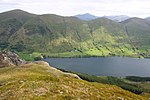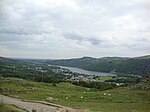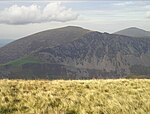Moel Eilio

Moel Eilio is a mountain in Snowdonia, North Wales, that is situated approximately 3 miles north-west of Snowdon itself. It has two subsidiary tops, Foel Gron and Foel Goch (Eilio). The average annual temperature of the mountain is around 6 degrees Celsius. During the winter season, some significant accumulations of snowfall is known to take place on Moel Eilio, due to its relatively flat, grassy slopes. A popular ascent starts from Llanberis and climbs by way of Bwlch y Groes and then the north ridge of the hill. Moel Eilio, Foel Gron, Foel Goch and Moel Cynghorion form a curved ridge tracking generally south-west towards Snowdon and can provide a less common route to ascend Snowdon.A small lake lies below the summit; Llyn Dwythwch.
Excerpt from the Wikipedia article Moel Eilio (License: CC BY-SA 3.0, Authors, Images).Moel Eilio
A4085,
Geographical coordinates (GPS) Address External links Nearby Places Show on map
Geographical coordinates (GPS)
| Latitude | Longitude |
|---|---|
| N 53.09688 ° | E -4.15953 ° |
Address
Moel Eilio
A4085
LL54 7YT
Wales, United Kingdom
Open on Google Maps










